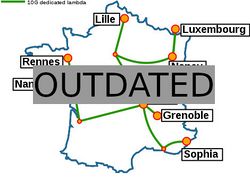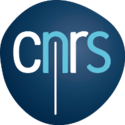Grid5000:Home: Difference between revisions
No edit summary |
No edit summary |
||
| (11 intermediate revisions by 3 users not shown) | |||
| Line 7: | Line 7: | ||
Key features: | Key features: | ||
* provides '''access to a large amount of resources''': | * provides '''access to a large amount of resources''': 12000 cores, 800 compute-nodes grouped in homogeneous clusters, and featuring various technologies: GPU, SSD, NVMe, 10G and 25G Ethernet, Infiniband, Omni-Path | ||
* '''highly reconfigurable and controllable''': researchers can experiment with a fully customized software stack thanks to bare-metal deployment features, and can isolate their experiment at the networking layer | * '''highly reconfigurable and controllable''': researchers can experiment with a fully customized software stack thanks to bare-metal deployment features, and can isolate their experiment at the networking layer | ||
* '''advanced monitoring and measurement features for traces collection of networking and power consumption''', providing a deep understanding of experiments | * '''advanced monitoring and measurement features for traces collection of networking and power consumption''', providing a deep understanding of experiments | ||
| Line 17: | Line 17: | ||
<br> | <br> | ||
Recently published documents: | Recently published documents and presentations: | ||
* [https://www.grid5000.fr/slides/2014-09-24-Cluster2014-KeynoteFD-v2.pdf Slides from Frederic Desprez's keynote at IEEE CLUSTER 2014] | * [http://www.silecs.net/wp-content/uploads/2018/04/nussbaum-grid5000.pdf Presentation of Grid'5000] during the 1st Grid'5000-FIT school (April 2018) | ||
* [https://www.grid5000.fr/ScientificCommittee/SAB%20report%20final%20short.pdf Report from the Grid'5000 Science Advisory Board | * [https://www.grid5000.fr/mediawiki/images/Grid5000_science-advisory-board_report_2018.pdf Report from the Grid'5000 Science Advisory Board (2018)] | ||
* Grid'5000 is merging with FIT to build the SILECS Infrastructure for Large-scale Experimental Computer Science. Read [http://www.silecs.net/wp-content/uploads/2018/04/Desprez-SILECS.pdf an Introduction to SILECS] (April 2018) | |||
Older documents: | |||
* https://www.grid5000.fr/slides/2014-09-24-Cluster2014-KeynoteFD-v2.pdf Slides from Frederic Desprez's keynote at IEEE CLUSTER 2014] | |||
* [https://www.grid5000.fr/ScientificCommittee/SAB%20report%20final%20short.pdf Report from the Grid'5000 Science Advisory Board (2014)] | |||
<br> | <br> | ||
| Line 27: | Line 32: | ||
<br> | <br> | ||
{{#status:0|0|0|http://bugzilla.grid5000.fr/status/upcoming.json}} | {{#status:0|0|0|http://bugzilla.grid5000.fr/status/upcoming.json}} | ||
<br> | |||
== Random pick of publications == | |||
{{#publications:}} | |||
==Latest news== | ==Latest news== | ||
<rss max=4 item-max-length="2000">https://www.grid5000.fr/mediawiki/index.php?title=News&action=feed&feed=atom</rss> | <rss max=4 item-max-length="2000">https://www.grid5000.fr/mediawiki/index.php?title=News&action=feed&feed=atom</rss> | ||
| Line 72: | Line 82: | ||
===Regional councils=== | ===Regional councils=== | ||
Aquitaine<br/> | Aquitaine<br/> | ||
Auvergne-Rhône-Alpes<br/> | |||
Bretagne<br/> | Bretagne<br/> | ||
Champagne-Ardenne<br/> | Champagne-Ardenne<br/> | ||
Provence Alpes Côte d'Azur<br/> | Provence Alpes Côte d'Azur<br/> | ||
Hauts de France<br/> | |||
Lorraine<br/> | Lorraine<br/> | ||
|} | |} | ||
Revision as of 18:54, 13 December 2018
|
Grid'5000 is a large-scale and versatile testbed for experiment-driven research in all areas of computer science, with a focus on parallel and distributed computing including Cloud, HPC and Big Data. Key features:
Older documents:
|
Random pick of publications
Five random publications that benefited from Grid'5000 (at least 2517 overall):
- Danilo Carastan dos Santos, Thi Hoang Thi Pham. Understanding the Energy Consumption of HPC Scale Artificial Intelligence. CARLA 2022 - Latin America High Performance Computing Conference, Sep 2022, Porto Alegre, Brazil. pp.1-14. hal-03845090 view on HAL pdf
- Mathilde Jay, Vladimir Ostapenco, Laurent Lefèvre, Denis Trystram, Anne-Cécile Orgerie, et al.. An experimental comparison of software-based power meters: focus on CPU and GPU. CCGrid 2023 - 23rd IEEE/ACM international symposium on cluster, cloud and internet computing, May 2023, Bangalore, India. pp.1-13, 10.1109/CCGrid57682.2023.00020. hal-04030223v2 view on HAL pdf
- Esteban Marquer, Pierre-Alexandre Murena, Miguel Couceiro. Transferring Learned Models of Morphological Analogy. ATA@ICCBR2022 - Analogies: from Theory to Applications (ATA@ICCBR2022), Sep 2022, Nancy, France. hal-03783959 view on HAL pdf
- Vladimir Ostapenco, Laurent Lefèvre, Anne-Cécile Orgerie, Benjamin Fichel. Modeling, evaluating, and orchestrating heterogeneous environmental leverages for large-scale data center management. International Journal of High Performance Computing Applications, 2023, 37 (3-4), 10.1177/10943420231172978. hal-04047008 view on HAL pdf
- Mohamed Aimen Djari. Study of the potential of graph-based approaches in blockchains. Cryptography and Security cs.CR. Université Rennes 1, 2022. English. NNT : 2022REN1S064. tel-03957362 view on HAL pdf
Latest news
Failed to load RSS feed from https://www.grid5000.fr/mediawiki/index.php?title=News&action=feed&feed=atom: Error parsing XML for RSS
Grid'5000 sites
Current funding
As from June 2008, Inria is the main contributor to Grid'5000 funding.
INRIA |
CNRS |
UniversitiesUniversité Grenoble Alpes, Grenoble INP |
Regional councilsAquitaine |


